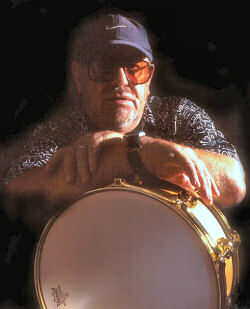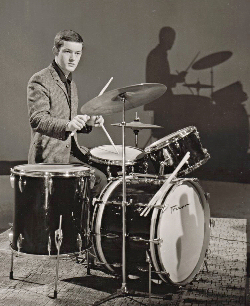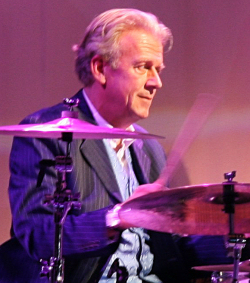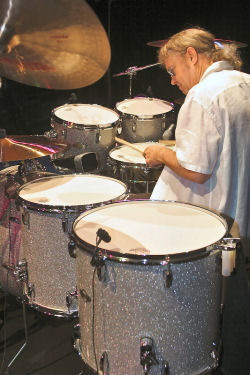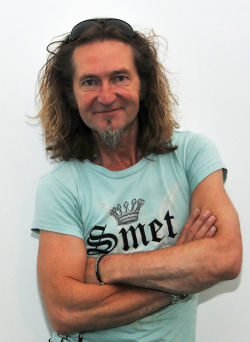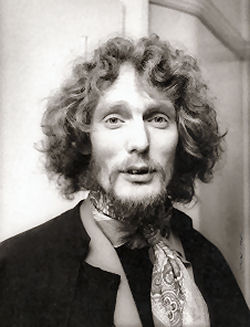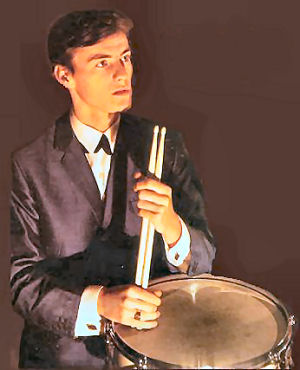
Daniel Joseph Anthony ‘Tony’ Meehan
Tony Meehan set the ball rolling as far as British Rock ‘n’ Roll drummers were concerned. It wasn’t so much that he was the first, although arguably he was, he simply was the one with the highest profile. He was on television with the guys everyone wanted to see: Cliff Richard and the Drifters. Would he have made it without Sir Cliff? Absolutely.
Daniel Joseph Anthony Meehan was born into an Irish family in Hampstead London, on March 2nd 1943. At school he had a desire to be a lawyer but was turned to the dark side of beat music in the fifties although he started respectably as timpanist in the London Youth Orchestra.
If Jerry Allison first made us baby boomer Brits aware that drums could have more of a lead role in Rock ‘n’ roll music by his unique drumming with Buddy Holly and the Crickets in the fifties, Tony Meehan reinforced the idea to us and we got to see exactly how he did it. (Everybody heard J.I. Alison but hardly saw him. There was ample opportunity to get it wrong and we all did. Not one of us played Peggy Sue in paradiddles as it should be played, we all used single strokes.)
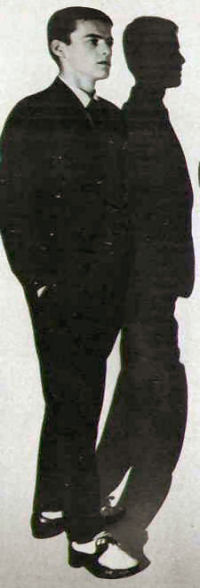
Tony and his Shadow
Tony Meehan had the highest profile any young British drummer had ever had three or four years before Ringo and showed us how to play drums in black and white on TV most Saturday evenings. Cliff and the guys were frequently on the couple of pop music shows of the time as well as the big variety shows like Sunday Night at the London Palladium and the Billy Cotton Band Show. Numerous spotty young drummers like me, Bobbie Elliott, Clem Cattini, Ringo, Mitch Mitchell, Cozy Powell, Dave Mattacks, Steve Ferrone and even John Bonham sat glued to our 12″ Bush TV screens to see if we could work out exactly how what we’d heard on record was done.
Before Tony we’d seen older jazzers playing their version of rock but they didn’t do it with feeling and attitude like Meehan did. You couldn’t be in a band in those days without playing Shadows tunes (or derivatives of them) and we all worked hard at playing exactly what Tony played. (I know I went out to buy a floor tom for my blue marine pearl Carlton kit so I could play the intro to ‘Apache’ properly which was the Shadows first No 1.) This record was a landmark in that not only was it top of the charts for six weeks, the Shadows went on to be the first instrumental group (and the first British artists) to top the UK album charts with ‘The Shadows’ which was their very first LP.
Tony was a virtuoso and something of a boy wonder since he lied about his age and joined Cliff Richard and the Shadows when he was just fifteen. He asked for and was granted time out of Grammar school to do this and never went back to school-type studying although, since he was just completing a PhD in Psychology just before his premature death he didn’t completely give up on academia. Prior to joining the Shadows, before whom John Lennon once said, there was no real music here in the UK, he also played in dance bands and Soho skiffle groups like The Vipers.

Tony as a recording artist
All this using a ‘bitsa’ drum set he’d been bought for Christmas by his parents from Blanks of Kilburn for £5.00.
The ‘2-Is’ coffee bar in London’s Soho was the mecca for rock ‘n’ roll music at the end of the fifties and young Tony replaced a very slightly older Brian Bennett in the house band there. Brian was away being an all-round-entertainer in a seaside resort. The house band not only backed the likes of Cliff Richard, Adam Faith and Marty Wilde, but also a whole generation of brylcreem–quiffed Elvis wannabees with names like Troy, Vince, Duffy and Nelson not forgetting a guitarist called Tony Sheridan whom the Beatles backed on their first record. Brian reversed the tables on Tony when he took over the drum chair in The Shadows which Tony vacated in 1961.
Eventually he graduated from the no-name kit to become an Ajax player. Ajax were the top British drums of the time made by Boosey and Hawkes in Edgeware and played by jazz guys like Jack Parnell. However by late 1960 he was playing what to us Brits, starved of American instruments was the Holy Grail, a four piece Gretsch ‘Progressive Jazz’ set in champagne sparkle. You can drool over this evocative set in the film ‘The Young Ones’ with Cliff and the Shadows. I was anxious to discover what had become of that iconic set and his last words on the subject were that his boys had split it up and he hadn’t seen it for years. (I heard through the grape-vine that it had turned up in Manchester but what Meehan told me makes me a little skeptical.). I do recall he had a shallow metal-shelled Slingerland snare he used in the studio rather than the Gretsch wood shell which came with the kit.
Tony was somewhat unique amongst young rockers of the time in that he actually went to drum lessons. He turned up regularly for an hour a week to be taught flams, ruffs, paradiddles and the like by a Scottish disciplinarian named Max Abrahams – and it showed. He had technique and could read music which stood him in good stead as a session player. But for my money he used drums which he only played for a few years, as a vehicle to take him to the next step: becoming an arranger and a composer. He certainly had no trouble playing the piano which was a sine qua non to work in those circles.
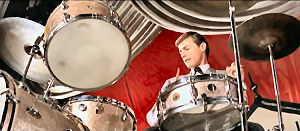
Tony with ‘that’ Gretsch kit
I first met Tony at a gig in 1960 and we became friendly when I joined Adam Faith. My brother-in-law-to-be was John Rogers a great bass player who wrote songs with Tony and when John joined Adam so did I. Tony had stayed with the Shadows until 1961 when he decided it was time he moved on. He was destined to get into record production and arranging eventually but initially he moved slightly sideways into making other instrumental records with his old colleague, bass player Jet Harris who’d left the Shadows a little after Tony. Their first record, ‘Diamonds’ went to number 1 in the charts and uniquely featured a very young Jimmy Page on guitar. The next record (Scarlet O’Hara) went to number 2. After the third record ‘Applejack’, Jet Harris was involved in a car crash and incapacitated so Tony formed The Tony Meehan Combo, a very jazzy rock outfit which for a couple of years had John Paul Jones on bass while John McLaughlin played guitar. (All this of course was years before Page and John Paul Jones formed Led Zeppelin and John McLaughlin created the Mahavishnu Orchestra.)
Tony moved on to A & R alongside Dick Rowe for Decca records in Hampstead.
A & R stands for Artists and Repertoire which was shorthand for the salaried position which the record producers of the time held. And, as the name obtusely suggests, involved finding songs for artists already signed to the big companies, booking studio time and musicians and overseeing them in the recording process. Sometimes even turning the products into hit records. Tony was good at this and I’m sure production suited his temperament more than being on the road. In those pre-motorway days when you’d need to allow two days to get to Cornwall – touring was tiring in the extreme. Tony told me he did a long US tour on a dodgy bus with Sir Cliff and the guys frequently traveling all night, sleeping upright with little real food. Tony remembered very little of all this because he slept through everything – except the gig!
There is a possibly apocryphal story that Tony was present at the infamous audition at the Decca studios when his boss, Dick Rowe turned down the Beatles and signed Brian Poole and the Tremeloes instead. Brian Epstein immediately whizzed the four moptops around the corner to EMI and the rest is history.
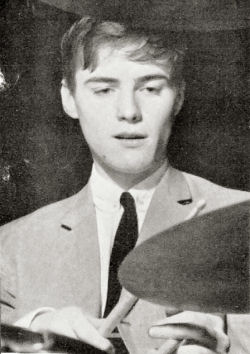
As a very young man
So Tony wasn’t just a great drummer he was a proper musician who composed, orchestrated, arranged and even engineered in the studio for the likes of Eric Burdon, PP Arnold, Tim Hardin, Wishful Thinking and many others including Roger Daltrey. In his time he drummed on records with John Leyton, Frank Ifield and Billy Fury and one day found himself putting some tracks down at IBC studios with ‘Ian Stewart and the Railroaders’. This band included Bill Wyman, Keith Richard and Ian Stewart! The tracks they recorded are allegedly lost but I’m sure Stones fans would pay good money to hear them.
Eventually A & R men realized they could make far more money producing records for themselves than taking a weekly wage from a record company so Tony became independent which meant he could work with whosoever he wanted, anywhere he wanted. This is how he came to be our producer when I was in the Roulettes.
Drummer producers can be a bit of a nightmare for the drummer in the band. I name no names but there was sometimes a frisson of impatience when the guy in charge felt he could do the drumming gig better and couldn’t wait to show the artist how to do it. Tony was nothing like this and on the contrary would deliberately come out to sit with me to ask how I was playing something. The first thing he ever said when we were routining a track was: “can you feel this tempo”. I don’t remember any other producer being interested in ‘feel’ in those days. It used to amuse me that when we were in the control room listening to a playback he’d be tapping his foot on the onbeat!
“I vividly remember 36 years after the event this very large female subway guard screaming after us as we escaped at speed: “Cops are gonna get yo ass!” She was too big to catch us but she had a gun!”
He was a very relaxed, gentle character although he wasn’t always ’mild-mannered Clark Kent’ either, after all he’d started out as a drummer! Perhaps he could best be described as a quiet hell-raiser.
When I first went to New York in the late sixties with Argent, Tony had been living there for quite some time producing the likes of Eric Burdon and we all got together. He asked if I’d like to see his side of the Big Apple. This involved no formal sight-seeing at all merely visits to several Irish bars via the subway – fortunately it was a day off!
Tony had a unique view of public transport, as far as he was concerned it was free. So traveling underground with him meant jumping over barriers and running away from subway police. This was a bit of a problem for someone like me who was new to America and had only just seen Easy Rider! I vividly remember 36 years after the event this very large female subway guard screaming after us as we escaped at speed: “Cops are gonna get yo ass!” She was too big to catch us but she had a gun!
Eventually Tony returned to the UK to get started on family life, producing seven children at least two (maybe three) of whom were/are drummers. One of his two daughters, Siobhan de Mare, is a singer.
I bumped into Tony at John Rogers’ mother’s funeral just before he died and we discussed the huge impact he’d had on British drumming – in the way that his colleague Hank Marvin had influenced the nation’s guitar heroes. Tony was self-effacing and really couldn’t see it but we arranged for me to go round and interview him anyway. Unfortunately I didn’t get there quick enough so the story will never be told.
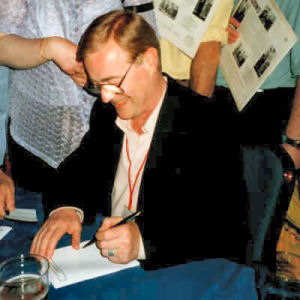
Tony Meehan
Funnily enough negotiations between me and Keith Moon were completed about me writing a book about him which for once was to be about his drumming rather than his mayhem. Unfortunately Keith shuffled off this mortal coil prior to me getting started.
Mental note. If you’re a high profile drummer it’s probably not a good idea to engage me to write about you if you want to live long and prosper!
I planned to ask Tony a load of questions about early influences, why he decided to play rock ‘n’ roll, what the Americans thought of him in the early sixties, how he managed to get that sound with just a couple of mics, what he thought of today’s drummers and who was his all time favourite.
It’s a shame, we’ll never know now.
Discography:
To hear Tony’s ‘chops’ check out ‘See you in my drums’ on the album ‘The Shadows’. It’s light years away from Sandy Nelson’s ‘Let there be drums’. Tony Meehan plays some stuff there which even 45 years after he recorded the track in one take, still sounds fresh and new.
Other tracks to listen to to get the essence of Tony Meehan are from ‘The Shadows’ LP: Shadoogie, Blue Star, Nivram, Gonzales, My Resistance Is Low and Big Boy. Also the single hits: Apache, F.B.I., The Stranger, The Frightened city, Man of Mystery, Kon Tiki.
E.P. Tracks: Mustang, Theme from Shane, Shotgun, Theme from Giant, Bongo Blues, 36-24-36.
All the Jet and Tony stuff: Diamonds, Scarlet O’Hara, and Applejack and of course all the recordings by Cliff Richard and the Shadows including Living Doll.

